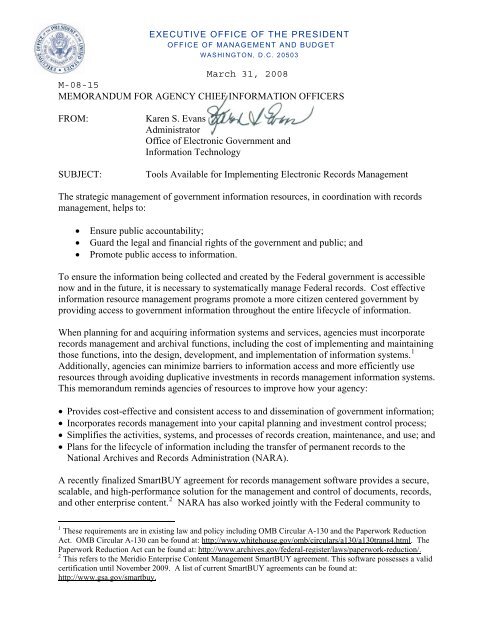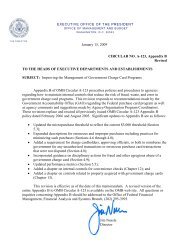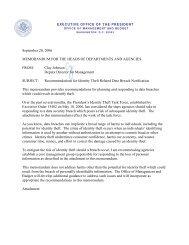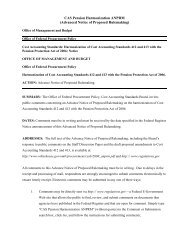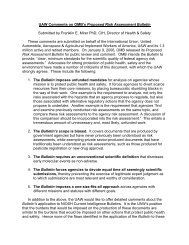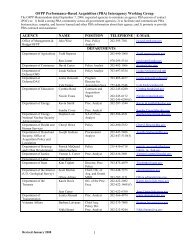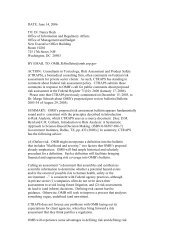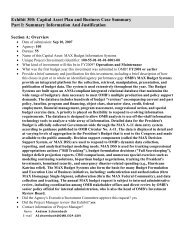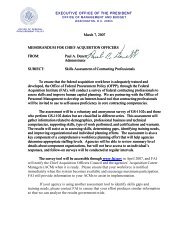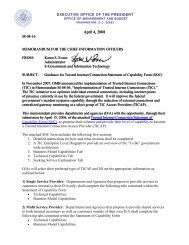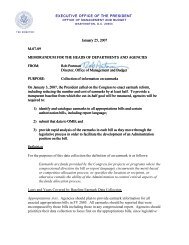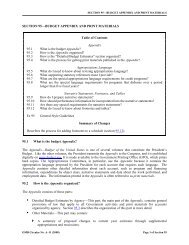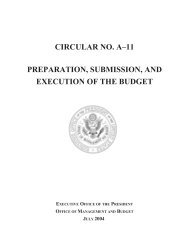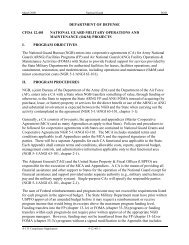March 31, 2008 M-08-15 MEMORANDUM FOR ... - The White House
March 31, 2008 M-08-15 MEMORANDUM FOR ... - The White House
March 31, 2008 M-08-15 MEMORANDUM FOR ... - The White House
You also want an ePaper? Increase the reach of your titles
YUMPU automatically turns print PDFs into web optimized ePapers that Google loves.
EXECUTIVE OFFICE OF THE PRESIDENT<br />
OFFICE OF MANAGEMENT AND BUDGET<br />
WASHINGTON, D.C. 20503<br />
<strong>March</strong> <strong>31</strong>, <strong>20<strong>08</strong></strong><br />
M-<strong>08</strong>-<strong>15</strong><br />
<strong>MEMORANDUM</strong> <strong>FOR</strong> AGENCY CHIEF IN<strong>FOR</strong>MATION OFFICERS<br />
FROM:<br />
SUBJECT:<br />
Karen S. Evans<br />
Administrator<br />
Office of Electronic Government and<br />
Information Technology<br />
Tools Available for Implementing Electronic Records Management<br />
<strong>The</strong> strategic management of government information resources, in coordination with records<br />
management, helps to:<br />
• Ensure public accountability;<br />
• Guard the legal and financial rights of the government and public; and<br />
• Promote public access to information.<br />
To ensure the information being collected and created by the Federal government is accessible<br />
now and in the future, it is necessary to systematically manage Federal records. Cost effective<br />
information resource management programs promote a more citizen centered government by<br />
providing access to government information throughout the entire lifecycle of information.<br />
When planning for and acquiring information systems and services, agencies must incorporate<br />
records management and archival functions, including the cost of implementing and maintaining<br />
those functions, into the design, development, and implementation of information systems. 1<br />
Additionally, agencies can minimize barriers to information access and more efficiently use<br />
resources through avoiding duplicative investments in records management information systems.<br />
This memorandum reminds agencies of resources to improve how your agency:<br />
• Provides cost-effective and consistent access to and dissemination of government information;<br />
• Incorporates records management into your capital planning and investment control process;<br />
• Simplifies the activities, systems, and processes of records creation, maintenance, and use; and<br />
• Plans for the lifecycle of information including the transfer of permanent records to the<br />
National Archives and Records Administration (NARA).<br />
A recently finalized SmartBUY agreement for records management software provides a secure,<br />
scalable, and high-performance solution for the management and control of documents, records,<br />
and other enterprise content. 2 NARA has also worked jointly with the Federal community to<br />
1 <strong>The</strong>se requirements are in existing law and policy including OMB Circular A-130 and the Paperwork Reduction<br />
Act. OMB Circular A-130 can be found at: http://www.whitehouse.gov/omb/circulars/a130/a130trans4.html. <strong>The</strong><br />
Paperwork Reduction Act can be found at: http://www.archives.gov/federal-register/laws/paperwork-reduction/.<br />
2 This refers to the Meridio Enterprise Content Management SmartBUY agreement. This software possesses a valid<br />
certification until November 2009. A list of current SmartBUY agreements can be found at:<br />
http://www.gsa.gov/smartbuy.
develop a set of requirements to be used to specify web services supporting various records<br />
management functions. 3<br />
<strong>The</strong> Office of Management and Budget (OMB) expects agencies to apply the existing<br />
requirements when acquiring and implementing information systems and services. OMB, in<br />
coordination with NARA, will monitor agency compliance with these policies as part of its<br />
oversight of agency information resource management programs. <strong>The</strong> following guidance<br />
documents will aid the implementation of existing law and policies when investing in an<br />
information system.<br />
1. E-Government Electronic Records Management Initiative 4<br />
This E-Government initiative provides tools for agencies to reference when managing<br />
their records in electronic form. <strong>The</strong> guidance and best practice documents produced<br />
through this initiative by NARA, the Department of Defense (DOD), and the<br />
Environmental Protection Agency on electronic records management help agencies<br />
transfer electronic records to NARA in a variety of data types and formats so they can be<br />
preserved for future use.<br />
2. DOD Electronic Records Management Software Application Design Criteria<br />
Standard, Version 2 (DOD 50<strong>15</strong>.2-STD) 5<br />
This DOD-issued standard endorsed by NARA sets forth mandatory functional<br />
requirements and identified recommended features for Records Management Application<br />
(RMA) software. NARA recommends agencies use the DOD standard and DODcertified<br />
products as a baseline when selecting an RMA to manage the agency's electronic<br />
records. Version 3 of the standard is currently undergoing review for NARA<br />
endorsement.<br />
3. Federal Enterprise Architecture (FEA) Records Management Profile, version 1.0 6<br />
<strong>The</strong> Records Management Profile provides the framework for embedding common and<br />
consistent records management procedures and practices into agency business processes<br />
to help cost-effectively ensure access to information. Agencies should use the Profile to<br />
identify records management issues, risks, benefits, and challenges during business<br />
process and information technology investment planning. To aid in this process, NARA<br />
has published checklists for agencies to use in implementing the goals of the Records<br />
Management Profile. 7<br />
3<br />
This refers to the Records Management Services Program which can be found at:<br />
http://www.archives.gov/era/rms/index.html.<br />
4 <strong>The</strong> guidance products issued by the Electronic Records Management Initiative can be found at:<br />
http://www.archives.gov/records-mgmt/initiatives/erm-overview.html.<br />
5 DOD 50<strong>15</strong>.2 can be found at: http://jitc.fhu.disa.mil/recmgt/standards.html.<br />
6 <strong>The</strong> FEA Records Management Profile can be found at: http://www.archives.gov/records-mgmt/pdf/rm-profile.pdf.<br />
7 <strong>The</strong> RM Profile checklists can be found at http://www.archives.gov/records-mgmt/initiatives/erm-guidance.html.
4. <strong>The</strong> Federal Enterprise Architecture (FEA) Practice Guidance 8<br />
<strong>The</strong> FEA Practice Guidance describes important concepts architects can use with<br />
stakeholders to deliver value to the business and improve results in agency mission<br />
areas. <strong>The</strong> Practice Guidance focuses on development of segment architectures and<br />
provides a context for applying the Records Management Profile to augment specific<br />
segment architectures to reflect records management requirements, shared services, and<br />
technology solutions.<br />
5. NARA Guidance for Implementing Section 207(e) of the E-Government Act 9<br />
NARA’s guidance highlights agency responsibilities to identify and schedule their<br />
electronic records and to transfer to NARA electronic records requiring permanent<br />
retention. Agency responsibilities for identifying and scheduling electronic records can<br />
be separated into two categories: developing records schedules for all records in existing<br />
electronic information systems and establishing procedures for addressing records<br />
management requirements, including recordkeeping requirements and disposition, before<br />
approving new electronic information systems or enhancements to existing systems.<br />
6. OMB Memorandum 06-02, “Improving Public Access to and Dissemination of<br />
Government Information and Using the Federal Enterprise Architecture Data<br />
Reference Model” 10<br />
Agency information resource management programs should already ensure the ability to<br />
access records regardless of form or medium. <strong>The</strong> procedures to organize and categorize<br />
information and make it searchable across agencies in OMB Memorandum 06-02 should<br />
be used to improve public access and dissemination of government information as a part<br />
of managing government information throughout its lifecycle. To cost-effectively<br />
implement these procedures, agencies should publish their information directly to the<br />
Internet.<br />
Many of the above guidance documents and additional resources from NARA and other<br />
organizations are available through NARA’s Toolkit for Managing Electronic Records. 11<br />
8 <strong>The</strong> FEA Practice Guidance can be found at:<br />
http://www.whitehouse.gov/omb/egov/documents/FEA_Practice_Guidance.pdf.<br />
9 NARA’s Guidance on Implementing Section 207(e) of the E-Government Act can be found at:<br />
http://www.archives.gov/records-mgmt/bulletins/2006/2006-02.html.<br />
10 OMB Memorandum 06-02 can be found at: http://www.whitehouse.gov/omb/memoranda/fy2006/m06-02.pdf.<br />
11 <strong>The</strong> Toolkit for Managing Electronic Records can be found at: http://toolkit.archives.gov.


